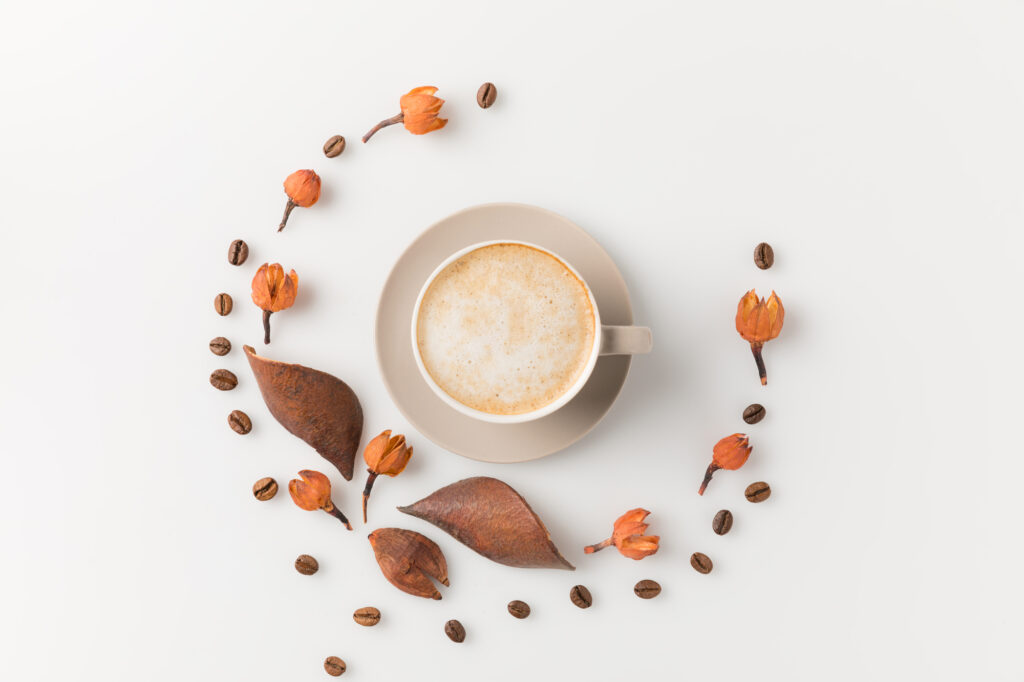Hojicha latte – the milky taste of the Far East
Drinking tea with milk isn’t something that only tea connoisseurs or the British Royal Family do. During human history, people adored adding a bit of their favorite creamer into a cup of strong, hot tea.
The new storming trend is Hojicha tea with the addition of milk. Or, as we prefer to call it, a Hojicha latte. As the Hojicha tea has a taste almost similar to coffee, the Hojicha latte is the next logical step in enjoying this unusual sort of tea.

A quick history of Hojicha tea
As Hojicha is Japanese green tea, its history goes much further than the coffee history of that part of the world. And as with all the great discoveries, Hojicha tea was discovered absolutely accidentally.
- In the 8th century, Buddhist monks from China brought green tea to Japan.
- Soon, green tea became popular in the upper class of Japanese society
- In the 13th century, zen master Eisai wrote his famous book: Kissa Yojoki (How to Stay Healthy by Drinking Tea). Green tea became even more popular.
- At the start of the 16th century, Japan opened its port to the rest of the world. The whole world loved Japanese green tea, and the sales rocketed sky-high.
- With that quantity of tea export, the tea industry needed mechanical machines to harvest and process the tea. The efficiency rose, but a lot of debris stayed on the fields.
- In 1920, one particularly bright merchant gathered all the leftover stems, stalks, twigs, and leaves from the tea harvest. Then he tried to roast them over some charcoal. Hence, Hojicha tea was born.
- Hojicha tea gained popularity across Japan, and now it’s conquering the rest of the world. Smokey aroma, full flavor, and delightful caramel nuances never fail to amaze tea lovers.
What is Hojicha latte?
If you ever tried Hojicha latte before, we are sure you didn’t forget that smooth, nutty taste. Well, tea lovers adore this perfect mix of high-quality green tea and steamed milk. The term Hojicha literary means roasted green tea(“Hoji” – roast, and “Cha” – tea). The leaves and the stems of the green tea plant are carefully picked and roasted. The roasting process frees the gentle caramelized notes of flavor, ideal for mixing with milk.
Hojicha latte is a gentle mixture of your favorite Hojicha tea and milk. But, cow’s milk is not your only option. For a healthier choice, try your Hojicha latte with goat’s milk. If you are lactose intolerant or a vegan, there is a way to handle that, too. Try making your Hojicha latte with oat milk, almond, hemp, or soy milk. The taste will be exquisite every time, we promise you that.
How do you make Hojicha latte?
Making a Hojicha latte is an easy process that will take 5 minutes of your time. You just need your favorite Hojicha powder or leaves, a tea bowl or a favorite cup, and a way to froth milk.
Step one – Grab a spoon
Put one teaspoon of Hojicha powder into a tea bowl. If you are using loose leaves, take two teaspoons.
Step two – Water time
Pour three tablespoons of hot (195F) water into the bowl. If you like your Hojicha latte stronger, use less water or more tea. Now is also a great time to add some sweetener of your choice.
Step three – Whisk!
If you are using powdered Hojicha, grab a whisk and start whisking vigorously. You can use a small electrical whisk or a Matcha whisk. Repeat the process for 30 seconds until you dissolved all the tea powder. When the air bubbles started to appear, you are ready for the next step.
Step four – Got milk?
Using your preferred method, heat the milk until a thick layer of froth is formed. Usually, it takes a milk temperature of 150-155F. You will get the best results by using a steam wand from the espresso machine, but you can also use a stovetop or microwave.
Step five – Pouring time
Using the circular movement of the hand, swirl the content of your milk pitcher. Still swirling, gently start pouring the milk into your Hojicha tea bowl. Finish with a thick layer of froth.
Step six – Get creative!
You can decorate your Hojicha latte with cinnamon powder, chocolate powder, or few leaves of loose Hojicha tea. Enjoy!
Tricks to take care of a weak coffee (that also work for your Hojicha tea).

Health benefits of Hojicha latte
Hojicha tea has slightly fewer health benefits than the rest of the green tea family. The reason lies in the roasting process that removes a lot of antioxidants from the leaves. But still, it has a plethora of health benefits:
- Relaxes your mind and clears the stress
- Gives your immune system a boost
- Lowers blood pressure
- A low amount of caffeine does well for your cardiovascular system
- Vegan option, if you include nut or plant-based milk
How do you drink Hojicha latte?
As Hojicha latte has a low amount of caffeine, you are not limited to just a morning cup. That’s a lifesaver for people who must limit their caffeine intake but still love that intoxicating taste of a good latte. You can drink your Hojicha latte even before sleep, as it will relax both your body and mind.
But when the summer days come, and it becomes too hot to think, we all tend to avoid hot drinks. Well, we have a solution for that. Prepare your favorite cup of Hojicha latte and pour it over some ice cubes. In a minute, you will get a tasty, refreshing, and healthy drink to enjoy at the beach.
Does Hojicha latte have caffeine?
A standard cup of Hojicha tea has cca 7.7 mg of caffeine, while a standard cup of brewed coffee has 95 mg! As the caffeine intake in Hojicha tea is next to none, Hojicha is the usual drink of the Japanese children.
Hojicha latte has several factors to thank for its low caffeine level. The first is the process of roasting the tea leaves at the 392F temperature. Most of the caffeine sublimes around 352F.
The second factor is the types of leaves used for making the Hojicha tea. Three main types of leaves are used in making the Hojicha tea:
- Sencha – higher caffeine percentage
- Bancha – medium caffeine percentage
- Kukicha (twig tea) – lowest caffeine percentage
And even the strongest Sencha leaves don’t have a high level of caffeine.
The third and most obvious reason lies in the fact that a good part of Hojicha latte is hot milk. And milk, as we all know, has zero caffeine.

Hojicha latte FAQ
How do you pronounce Hojicha?
You pronounce the “Ho” using a long “O”, like in “home”. The “Ji” part is pronounced as the letter “G”, and the “Cha” part is pronounced similar like in the word “Matcha”. It’s a bit tongue twister, but you’ll get the grip.
What does Hojicha latte taste like?
Hojicha latte will taste a lot like the usual cafe latte, with the smokey tea note. So, you can even serve it to your coffee-loving friends. The main difference is that Hojicha latte is mostly drunk unsweetened or with a bit of organic maple syrup. The taste of the Hojicha latte may vary with the different tea roast levels, similar to the difference between the coffee roast levels.
What else can you make from Hojicha powder?
Besides usual tea drinking or latte, Hojicha powder is used in numerous things. From making Hojicha hot chocolate mix to baking Hojicha biscuits and even making beer. But perhaps the most famous product is the KitKat Hojicha. For a long time, KitKat Hojicha was a Kyoto-limited flavor, but now it’s available all over Japan. Every part of this popular KitKat chocolate was flavored with the Hojicha tea powder.
Conclusion
Just like matcha, Hojicha quickly found the way to our hearts and the shelves of our supermarkets. Nowadays, you can even buy a Hojicha latte in cans! Pretty good for an exotic tea from the Far East.
Even the most stubborn coffee devotees were surprised with the mouthful taste of the Hojicha latte. Try it yourself, and I guarantee you won’t be sorry.






